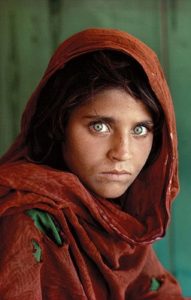The Soviet–Afghan War lasted over nine years, from December 1979 to February 1989. During that period the Soviets had attempted to eliminate civilian support for the mujahideen’s guerrilla forces by bombing and depopulating rural areas. These tactics sparked a massive flight from the Afghan countryside. By 1982, some 2.8 million Afghans had sought asylum in Pakistan.
It was 1984 when American photo journalist Steve McCurry photographed a 12-year-old Afghan orphan girl with beautiful, green, piercing eyes in a school tent of the Nasir Bagh refugee camp on the edge of Peshawar. Her parents had been killed during the Soviet Union’s bombing of Afghanistan.
“We left Afghanistan because of the fighting,” said her brother in an interview. “The Russians were everywhere. They were killing people. We had no choice.” Shepherded by their grandmother, the girl, her brother and three sisters walked to Pakistan. For a week they moved through mountains covered in snow, begging for blankets to keep warm. “You never knew when the planes would come,” he recalled. “We hid in caves.”
Steve McCurry used his Nikkor Ai-S 105mm f/2.5 lens to shoot the iconic portrait photo:


In June 1985, the photo appeared on the cover of National Geographic magazine. It has become the most recognized photograph in the history of the magazine:

In 2002, 17 years later, a team from National Geographic returned to Pakistan to search for the Afghan girl with the green eyes. When they found her, an FBI analyst, forensic sculptor and the inventor of iris recognition verified her identity. The woman, named Sharbat Gula, was exactly the person who was photographed by Steve McCurry in 1984. Until 2002, she had absolutely no idea about the world wide popularity of the iconic photograph showing her:
Read the details of the search for the Afghan girl with the green eyes here:
https://www.nationalgeographic.com
In 2016, Sharbat Gula, was arrested in Pakistan for living on fraudulent ID papers:
Using forged Pakistani identity cards is a common practice among the 1 million Afghan refugees who still live in the country without legal status. Sharbat Gula was facing up to 14 years in prison and a $5,000 USD fine for the crime. At that time, Sharbat Gula was raising four children and was suffering from hepatitis C, which was the same thing that had killed her husband years earlier.
When she was arrested and accused of having a fake Pakistan ID, it became a national cause for Afghans and the Afghan government. Sharbat Gula was released and returned to Afghanistan with her children and heartily welcomed back by the government there.
In Kabul, Sharbat Gula was welcomed by President Ashraf Ghani and former President Hamid Karzai, who promised to support her financially and to ensure that her children would have health care and schooling. In December 2017, Sharbat Gula was gifted a 3,000-square-foot residence in Kabul for her and her children to live in.
Find more details about Sharbat’s return to Afghanistan here in 2017:
https://news.nationalgeographic.com
In 2021, Italy was one of several Western nations that airlifted Afghans out of the country over the summer amid striking scenes in which thousands of Afghans scrambled to Kabul’s main airport to seek international evacuation and safety. Human rights activists have said Gula was at risk because of her high profile. In November 2021, the Afghan Girl’ from National Geographic cover was evacuated to Rome, Italian government says.
Find more details about Sharbat’s evacuation to Rome, Italy in 2021 here:
https://www.washingtonpost.com
See Tony Northrups interesting view on the downside of the iconic photo of the Afghan girl with the green eyes:
Want to see more exceptional photographs from the photographer of the Afghan girl with the green eyes, Steve McCurry? Have a look here:
Photograph gallery of Steve McCurry’s Homepage

See more technical information about this legendary vintage lens here: https://tech-reviews.swiss-1.ch/prime-lenses